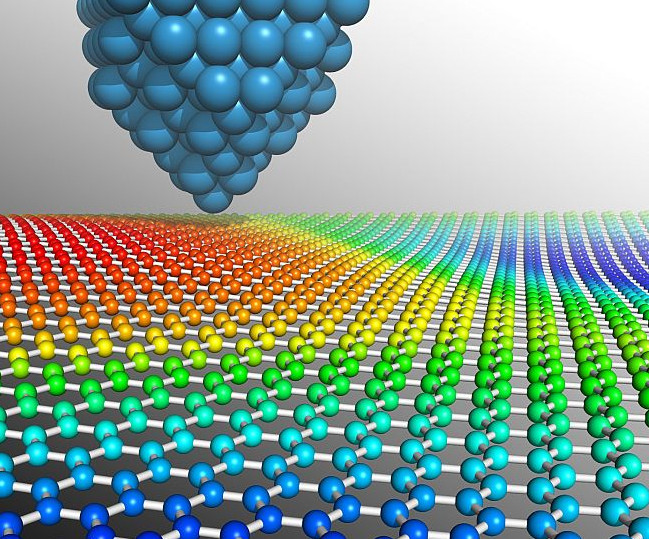

One of the great inventions of the late 20th century was the scanning tunneling microscope or STM, which is a device that allows one to non-destructively image molecules and surfaces of substances with sub-atom resolution, even for molecules and surfaces immersed in liquids. The invention has had a huge impact on fundamental science, engineering and technology, and STMs have become a standard piece of equipment in many biology, chemistry, physics, engineering labs as well as in commercial companies.
The main idea involves quantum tunneling, which you will learn about this semester as an important and surprising quantum mechanical property of tiny masses moving in the presence of some repulsive barrier. In the above figure, a surface of the pure carbon compound graphene is being scanned by a sharp tungsten metal tip (what looks like a pack of blue grapes towards the back of the image, with each ball being the artist's rendition of a tungsten atom). This involves maneuvering the tip so that it is just a few atoms distance above the surface, and then by applying a voltage difference between the electrode and graphene surface so that electrons tunnel from the surface to the tip, producing a tiny but measurable current. Because the tunneling of electrons through a potential barrier is extremely sensitive to small changes in the height of the barrier, which in turn is affected by the geometry of the surface and atomic composition of the surface, a scanning tunneling microscope can produce extraordinary images (e.g., see this website and this website) of a surface or molecule by monitoring the tunneling current as the tip is scanned over a surface (always remaining a few atoms distance above).
Later variations of the scanning tunneling microscope have led to further extraordinary abilities at the molecular level. Of enormous value to biophysicists and engineers is the atomic force microscope that allows a researcher to pull on a single molecule, e.g., a piece of DNA with one end attached to a rigid surface, and simultaneously measure the force on the scanning tip as the molecule is slowly stretched out.
Another variation of the STM allows one to pick up individual atoms
and place them in particular locations on some surface, creating words
or
images or just bits of information. This may lead to the ability
to store and read out information at the atomic level, which means
that one could store about 1014 bits of information on a
square centimeter surface, a 100-fold improvement in information
density over current and much larger hard disks. (But accessing the
information is currently much slower, one needs to invent massively
parallel readout tips to speed things up.)